Artbility (August 2003)
This report is provided by David Stuchbury through Japanese Society for Rehabilitation of Persons with Disabilities (JSRPD)
Talking to Mr Tohara at Tokyo Artbility he wants to make two things particularly clear. Tokyo Artbility is not a charity organization (It's a profit making business with minimal government funding, and it doesn't exist only to serve the needs of its disabled clients, but like any business also to make money. How it does this, by ensuring its clientele get a good deal and are treated first and foremost as artists, has ensured Tokyo Artbility`s status as the number one company of its kind in Japan.
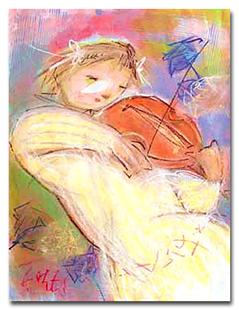
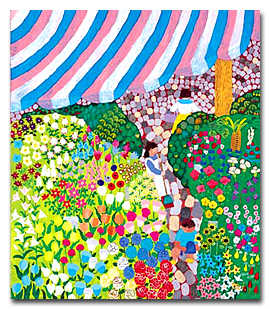
Established in 1986, Tokyo Colony, the larger umbrella organization had originally been committed to printing. Needing an illustrator for particular copy they discovered someone working in the print section with a talent and used his talent rather than hiring an outsider.
They decided to develop this idea, never really knowing if would generate enough interest or become successful, but believing in the fundamental idea. Tokyo Colony already had many disabled people working for them in other areas, but used direct mail to contact others about an art venture. This approach proved not without difficulty. Education establishments and schools for disabled people seldom replied to direct mail, citing the reason as a traditional division between the employment and education sector for disabled people.
Artbility struggled to make an impression on a wealth of talent, working at a snails pace, in a country already renowned for slow business styles, and succeeding, Mr Tohara says, primarily because of the fundamental principle that this was a commercial venture - money should be made, and should go to the artists.
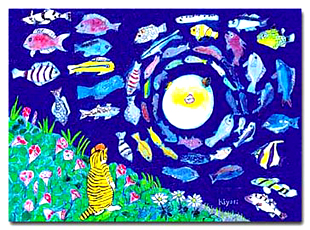
Tokyo Colony capitalized its strengths as a well established printing business with media connections. The media sympathized with the concept and a television program documented the venture. Today Tokyo Artbility has 100 Artists on its books and around 3,000 works are being used.
So what is the work like? Is it any good? Looking at the array of calendars, postcards, wine bottles, jam jars before me in the Artbility Office the answer is clearly YES, its wonderful. As Mr Tohara emphasizes - There is no disability in talent. But what of the special qualities of the disabled artist...the resonant factors that communicate to the individual?
Well that of course is a very difficult question to answer objectively, and all the artists have unique talents and perspectives. Perhaps the strong sense of bright positive colors should be noted, a common playfulness with the subject - often animals; a return to the fundamental factors of life: love, companionship, nature.
Of course Artbility takes work from people with different kinds of disabilities, and as such different work stands out for different reasons.
Of special note would be Lukemia sufferer Mr Koike who's extremely sophisticated pieces underline a continued long search for the meaning of life. His paintings deserve favorable comparison with Salvador Dali`s, while providing more accessible and warmer depictions of fractured cityscapes, theme park figures, mother and child, ideal worlds. Work reveals a depth and imagination brought about perhaps due to difficulty traveling.
Another artist, unable to draw perspectives accurately following a car accident, paints a cat playfully eyeing a pond full of circling fish. The disability here is actually the most endearing quality of the piece. His wife has added that following the accident and rehabilitation he now draws more understandable and accessible pictures. He remains unsatisfied though.
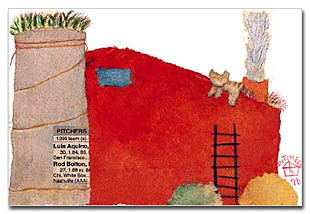
Artbility, by copying original works and collecting a fee from the commercial source that uses them ensures that work can be used many times for different purposes. For disables artists, who may work slowly and have less opportunity to self-publicize this has some advantages over selling originals through a gallery or auction. While an original may expect to fetch as much as 50,000 yen and a calendar piece sees only 20,000 of that go the artist, an additional feature on a magazine page entitles the artist to 60% of 100, 000 yen. Such accumulative benefits to the artist in the commercial field are notable.
The people at Artbility select art to suit a specific need and communicate with the client or with the family of those with mental disabilities. A judgment meeting is held once every two months; the judges being graphic designers, actively involved in the field, who choose work not just by creative merit, but in accordance with its commercial viability. The judges then have the responsibility to sell work, so judgment levels are very strict. Artbility receives about 100 works every 2 months, of which only 10% are accepted.
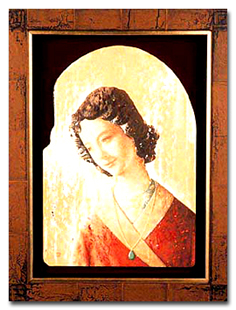
Tokyo Colony has other projects. There are 8 branches overall including a digital media center and a workshop for people with disabilities. It produces painting, clothes and emergency and mail delivery products. Of particular note is e.com - the biggest database for work by children in Japan. At the moment this is primarily an outlet for parents to showcase their childrens work on the net, but could develop into a commercial venture like Artbility.
While Artbility doesn`t usually exhibit work, once a year a small gallery in Ginza provides an opportunity for the public to appraise and enjoy the combined vision of its artists. Mr Tohara says that the usual reaction is that the work, "Heals their souls, brightens their hearts and minds". Leaving the Artbility office with a stack of artist`s postcards I can endorse that sentiment completely.
Compiled by the Japanese Society for Rehabilitation of People with Disabilities (JSRPD)
